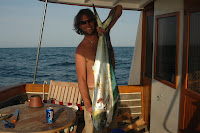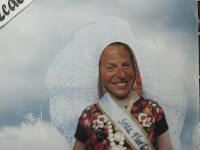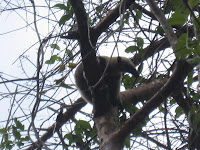Captain's Blog

Captain’s Report
For those of you who don’t know, I grew up “captaining” 10 foot skiffs with electric motors. On more than one occasion, while crossing a “channel” (the low spot between the pond I lived on and the next), I freaked out.
In my family, the call of, “Hey Dad, it’s your old friend Greg!”, is somewhat of a joke. I actually yelled that on quite a few occasions, trying to get “help”, though shore was only 5 feet away.
Ocean crossings – even being on the ocean – is not something I am accustomed to. But if there is one thing I learned from my dad, it is the importance of confidence. He would call it bullshitting, but there really is no difference.
My job as captain is to keep my crew safe, to prepare for any eventuality, and I believe I have done this. We have a satellite phone, an EPIRB (emergency beacon), an actual lifeboat. 4 vhf radios. For piracy, we have tear gas hand grenades, “flare” guns, and slinghshots. I’m a pretty good slingshotter.
I monitor the weather, and make the call as to when we press on, and when we seek safe harbor.
We had a set date to leave San Diego – March 10, regardless of ocean conditions. Henrietta II is a true bluewater (ocean-going) trawler, and should be able to handle any seas. Considering the passages we have ahead of us (Panama to Aruba is one of the four most difficult on earth), I did not want to wait for the best sea conditions. This is the reason why:
Diesel engines, particularly the one that powers Henreita II (Ford-Lehman 135, a modified tractor engine), fail for only one reason – bad fuel. “Bad fuel” means diesel contaminated with water, sludge, etc.
When we bought Henrietta II, her tanks were full. A seller would normally advertise that a boat is fully fueled (700 gallons @ 4$ per gallon – that’s an additional $3000+ of value). The previous owners did not even mention that the tanks were full – I was worried that there was something wrong with them, that the fuel was old, etc.
I wanted to give her a true sea trial – on the baja coast, SeaTow would respond to any emergency, so it was better to have a problem arise there than . . . than anywhere else.
The passage from San Diego to Ensenada was a cakewalk, one we had planned for and expected. Well, almost a cakewalk – we blew a hydraulic hose while we were docking, losing control of the thrusters. Fortunately, the marina staff had caught a line from Sam and were able to pull us in.
A funny incident (in hindsight) occurred that night. After walking the dogs, I noticed a man, visibly drunk, fiddling around on the dock. Dogs at my side, I wasn’t worried, but gave him a stern “Buenos noches” so that he knew I was watching him.
He followed my, down our finger, at which point I stopped, turned, and would not let him pass. Well, I made sure the dogs would not let him pass. He started yelling at me in Spanish, and from my rudimentary knowledge, he was asking me who I was, why I was there. He became agitated, talking about “perros negros” (black dogs). I told him, in spanish, to call the marina managers. He did no such thing, leading me to believe he was some drunk who had managed to sneak on the dock. He continued to advance towards me, so I gave the dogs a little slack for good measure. He showed me a key card – great, I have three of those from places I used to work. Jeff asked for “otros ID”, and he did not provide any. I gave the dogs a little more slack, said “andele!”, and he left, clearly upset.
I later realized, when a uniformed security guard came down our finger, that the man I sicked the dogs on was security, and needed to scan a chip at the end of the dock to prove he had done his rounds. I laughed, but at the same time, if you’re going to be drunk on the job, at least wear your uniform. I would have done the same thing to someone at Seaforth (our marina in San Diego).
I had hoped to spend a few days in Ensenada to get some systems fixed where labor is cheaper, but the weather window for our next stop (Turtle Bay) closed rapidly. Either we would leave within 48 hours of arriving, or we would be there for at least 7 days. Hindsight puts it at 13, and growing.
I made the call to leave for Turtle Bay.
I had never been out in 10 foot seas, nonetheless 10 foot seas at 10 seconds (the seconds matter more that the height – 10 feet at 20 seconds is almost calm, but when you have another 10 foot wave 10 seconds behind you, it makes for a rough journey).
Henrietta II and her crew performed like a dream. We were expecting 10 feet at 15 seconds, and got 10 feet at 10 seconds – a huge difference. Nonetheless, between the autopilot, stabilizers, and, most importantly, the steely nerves of our crew, we made it to Turtle Bay both unscathed and confident.
I will never forget Jeff and I harmonizing Smiths songs at 3 AM, with walls of water approaching from starboard. What else could we do but enjoy the moment? And how often do you dinf someone who can sing harmony, especially to The Smiths?
Our next destination was San Juacito, where our friend Steve Winn lives. No, he does not own hotels in Vegas – that’s spelled Wynn,
What was supposed to be at least a calmer passage turned difficult when we were again hit rough seas, a mishmash of 6 footers with no pattern, making it difficult for the stabilizers to compensate, and difficult for us to tolerate. Approaching Cedros island at night was unnerving at first – the lighthouse was not visible – but we were relieved to be in its shadow, calming the seas – for now.
At the South end of Cedros island I had what is still, to this point, the most unnerving moment of the trip. There, in the middle of the channel, was a massive tanker (we actually thought it was land at first). It seemed too far out to be anchored, in well over 200 feet of water. My numerous attempts to hail the vessel on channel 16 to determine if they were anchored, traveling, etc., returned nothing but radio silence. I made the decision to pass to her stern, hoping that she was not anchored both bow and stern, nor moving in reverse. The call was a good one, but in the process I became so disoriented that I completely lost my bearings.
Lack of sleep had finally taken its toll, as I realized this wasn’t a road trip from college where I could drive all night. There is a reason why people stand watch while others sleep – and that was the reason.
Rounding the corner past Isla Navidad, we thought everything would be better – we would be protected from north winds by land. And we were, until we passed Bajos Wright. This area has an estuary surrounded by mountains on both sides, creating a perfect funnel for winds. They reached gale force in a matter of minutes, kicking up even larger seas than we had seen before. I had gone to sleep in glassy seas, only to be awakened by the crash of . . . everything being tossed about the boat. Those 40 miles were the roughest we have seen so far. 40 miles may not seem like much, but at 7 knots, that’s almost 6 hours. We passed the shadow of Mt. Thetis, and the seas finally calmed.
And then the fog settled in. Radar was literally our only eyes, but after what we had gone through, we were happy to have calmer seas even if it came at the expense of visibility.
We eventually made it to San Juacito, but the fog remained thick, and winds came out of the southwest (highly unusual for Baja). This would make anchoring difficult, if not impossible. Then, on our approach, the autopilot gave out.
Autopilot may seem like a luxury, but it is not – it is one of the most important pieces of equipment on an ocean-going boat. I don’t care how good a of a sailor you are, you cannot keep a course with following seas as well as an autopilot can.
I made the decision to not stop at San Juacito, but to press on. And not to Mag Bay, to Cabo. I consulted the crew, and they agreed. We would do a 60+ hour journey, hand-steering the last 30 hours.
The strangest thing happened during my shift. We all knew that the autopilot was not working, but I set it anyway. And I did not have to touch the wheel for the entire two hours. My crew probably thought I was crazy, but I thought then, and still do, that my father, the namesake of Henrietta II, had taken over and steered for me. The autopilot hasn’t worked since – for me or anyone else.
Due to the change of plans, we arrived at Puerto Los Cabos at night. I had called ahead on the sat phone to make sure that someone would be there to guide us in. Upon approach, we received a mishmash of signals – apparently the night crew did not speak English, so they had to find someone who did. They eventually guided us to our slip, when, once again, the thrusters stopped working. All I could do was laugh. We actually made it in perfectly, using the propwalk (tendency of a single screw boat to back in a specific direction) to get us straight in to the slip.
We spent 2 days in Los Cabos. They charge 4 times the average for a slip in Mexico, so I wasn’t going to stay any longer than that – we would have to hand-steer across the Sea of Cortez to Mazatlan, but a 30 hour trip after what we’d been through didn’t seem that bad.
And it wasn’t. My only complaint was that we didn’t catch any fish.
As we approached Mazatlan, I checked my email and discovered that the marina office we were supposed to stay at wouldn’t be open until Tuesday. This could mean two days being unable to get off the boat. I quickly called another marina, who told me they had space for a 42 foot boat.
The slip certainly looked small upon arrival. Apparently the marina staff’s English was lacking – they thought we were 22 feet! We tied up anyway, the thrusters working perfectly.
The website for this marina showed a pool, jaccuzzi, etc. They actually did exist (unlike the multiple infinity pools at Los Cabos) but hadn’t been treated in probably a year. With Monday being a holiday, there was no point in us staying – it was a dirty marina and we couldn’t get the autopilot repaired until Tuesday at the earliest. It would be a one night stay, then on to Puerto Vallarta.
We fueled up on our way out. I was thrilled with the price of diesel 9 pesos per liter, less than $3 per gallon. Then I found out they add 14 percent for the docking. I objected, but the marina, dock, and fuel company are all owned by the Mexican government. I will take it up with my credit card company – once we leave Mexican waters.
The crossing to PV was a dream. We caught 2 massive dorado (aka mahi mahi). Upon entering the bay, we were treated to the most incredible whale show – a mom teaching her pup how to breach (jump out of the water). One after the other, they would sail in to the air, crashing into the ocean to the delight of all of us.
We are now in PV, and will be here . . . until the autopilot is fixed.
Captain Greg~


Loving the Blog, Greg...had bad luck myself on the south side of Cedros. That 'anchorage' near the old mine was our nearest refuge from a winter storm, but someone must have greased the bottom. We were unable to get anchors to stick in any location and spent the stormy night on abridged watches, trying to get a nap in. No Sleep till Mag Bay!(apologies to the Beastie Boys). Keep writing, so I can enjoy my vicarious tacos.
ReplyDeleteKnowing your Dad, Mom and brother Brian so well I am delighted by your seafaring bug. Being the " Joshua Slocum " of armchair sailors I am enjoying your every adventure.
ReplyDeleteBut, please don't fall off the end of the Earth !